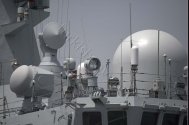But in this case the HQ-16 PAR is mounted on both ends of the ship instead of an integrated mast. Wouldn't that increase the blindspot area, especially around midship?I would expect it to be more capable than the SR2410C, yes.
As for the mounting points, the HQ-16 guiding PARs have the same FOV and quadrant view like say, the Type 346 faces on the 052C/D/055, the SPY-1 on the Burkes, as well as the tiny PARs on the ECM units. There is going to be some loss as you steer off center the array, typical of all PARs versus mechanically steering units, but the negatives may not outweigh the gains of using these PARs, or they won't be chosen.
It is also no different in terms of angles such as these CEAMOUNT illuminators.
View attachment 76012
You are using an out of date browser. It may not display this or other websites correctly.
You should upgrade or use an alternative browser.
You should upgrade or use an alternative browser.
054/A FFG Thread II
- Thread starter tphuang
- Start date
But in this case the HQ-16 PAR is mounted on both ends of the ship instead of an integrated mast. Wouldn't that increase the blindspot area, especially around midship?
That depends on the phase array steering angle. I believe this one should do at least +60 degrees to -60 degrees or about 120 degrees in azimuth and elevation. Or maybe someone figured out they can do even more, like +70 degrees to -70 degrees like this study over here.
I suppose that works, but the blindspot is still bigger than if the PARs are integrated more tightly. I'm nitpicking at this point, but is there absolutely no way to integrate those PARs on the main mast?That depends on the phase array steering angle. I believe this one should do at least +60 degrees to -60 degrees or about 120 degrees in azimuth and elevation. Or maybe someone figured out they can do even more, like +70 degrees to -70 degrees like this study over here.
also, the old MR-90 can mechanically turn to direct the guidance right?
I suppose that works, but the blindspot is still bigger than if the PARs are integrated more tightly. I'm nitpicking at this point, but is there absolutely no way to integrate those PARs on the main mast?
also, the old MR-90 can mechanically turn to direct the guidance right?
I am not sure if you still have a blindspot. Remember the PARs start by facing 45 degrees from the ship's centerline, and the sides are going to be more than covered with a 120 degree arc, or maybe even a 140 degree arc. The question should be how much -db loss from the beam steer. They should have already figured all these out, long before they can top this with multibeam engagement against multiple targets or extended range against a single or few targets.
I believe these things are going for the 054B/057 next gen frigate, and they may or still may not go into an integrated mast.
The other theory is that these are not SARH illuminators but datalinks, with the HQ-16 now converted from SARH to ARH guidance.
The MR90s should mechanically rotate.

What does "PAR" mean?I am not sure if you still have a blindspot. Remember the PARs start by facing 45 degrees from the ship's centerline, and the sides are going to be more than covered with a 120 degree arc, or maybe even a 140 degree arc. The question should be how much -db loss from the beam steer. They should have already figured all these out, long before they can top this with multibeam engagement against multiple targets or extended range against a single or few targets.
I believe these things are going for the 054B/057 next gen frigate, and they may or still may not go into an integrated mast.
The other theory is that these are not SARH illuminators but datalinks, with the HQ-16 now converted from SARH to ARH guidance.
The MR90s should mechanically rotate.
View attachment 76025
Or phased array radar? I saw this in another article but it was not explained what this acronym is for.^Passive Array Radar I believe
I wonder that they don't install a new AESA instead.The PLAN ship still has the Type 382
What does "PAR" mean?
Phased Array Radar for short. Refers to both active and passive phase array.
I wonder that they don't install a new AESA instead.
They did install new target illuminators, which I believe to be AESAs.
People don't seem to get this but this means a new version of the HQ-16 is going to go with it.
